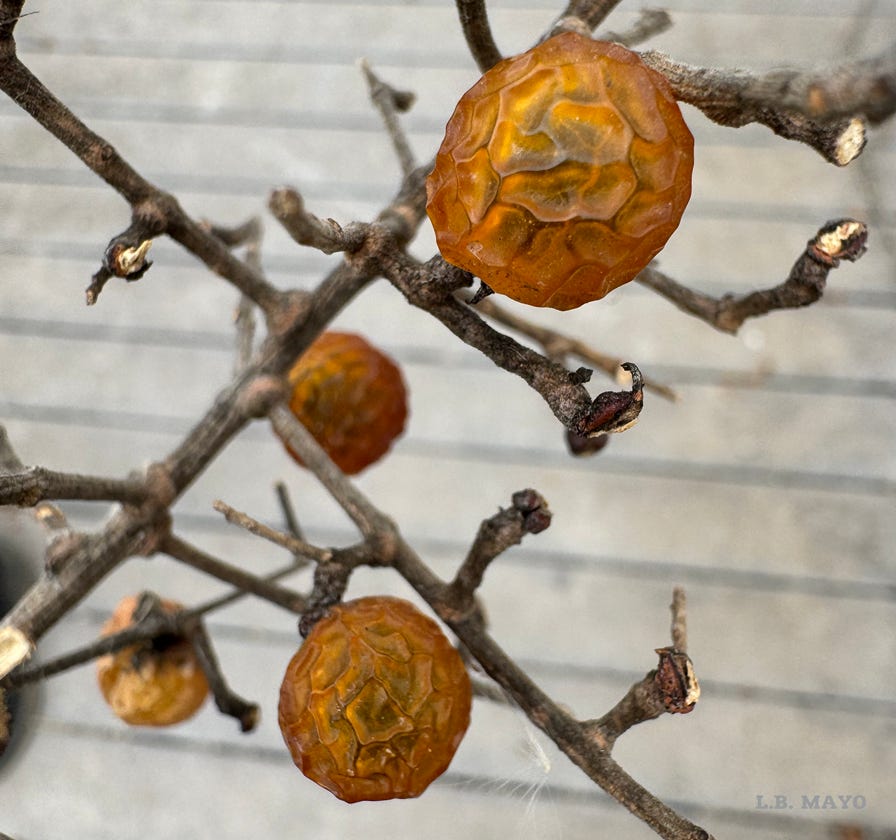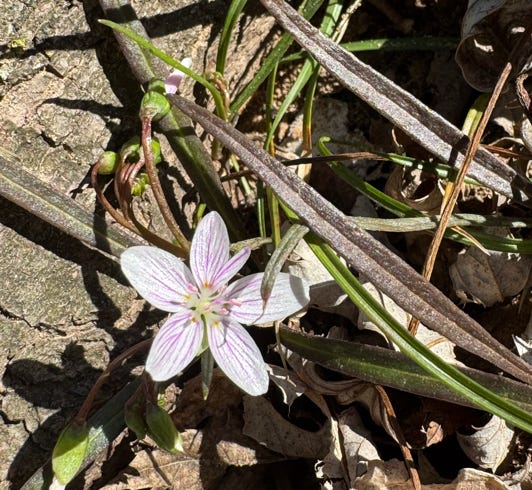Strange Fruit
A few weeks ago, after a family hike, we walked the Horton Slough Trail at Sequoyah National Wildlife Refuge. On the old walkway at the north side of the slough there was crunching underfoot and the bridge was scattered with odd orange fruits and large black seeds. I picked a few of the fruits up for closer inspection and they were translucent, wrinkled, orange spheres. On the ground a few had been split open by foot traffic and I realized the fruit was the source of the seeds, obvious in retrospect, but invisible from the outside despite the translucency. I’d just discovered Soapberry, though I wouldn’t know it until a few weeks later.
After multiple annoying Google results confidently yielded the incorrect results of Osage orange and persimmon, I resorted to poring through the county tree listings for the state of Oklahoma. I spent what I’m hoping was under an hour or so searching every unfamiliar tree name in the three counties the refuge encompasses until I finally hit pay dirt. My unknown tree was Soapberry, formally entitled Sapindus drummondii by science.
After the successful identification, an entry in Wikipedia informed me that soapberry is native to the U.S. and Mexico. Its strange fruit is toxic and irritating and has such a high concentration of saponin that it’s been used to launder clothes in some areas. The fruit has been used to stun fish, similarly to the rotenone from tropical plants used in South America, and this made me rather curious that the parent tree was growing at the edge of the water. Perhaps some years ago someone had tried to fish the slough utilizing it, and this mature tree was the result. Being appealing and useful to humans will likely be a more and more impactful survival trait for species in the future, but I’d guess soapberry’s appeal has waned due to legal regulations on fishing techniques and inexpensive and effective detergents.
Saturday Mar. 29, 2025

Globular, translucent orange fruit of Soapberry
at Horton Slough of Sally Jones Lake in the Sequoyah National
Wildlife Refuge, near Vian, Oklahoma, Spring 2025
It’s been quite a few years since I’ve written in a blog and hopefully being older and wiser, I’ll do a bit better this time around. This one is under my own devices and design so the glitches and ad hoc appearance are all my doing and responsibility. I threw a few odds and ends out on to the web about four or five years ago, told myself with the best of intentions that it was just temporary and I would work on the design. I fully expected to beat it into a more tasteful, slick piece in keeping with the impressive templates available from nearly every web related company out there right now. That never manage to occur.
The program I’m using, Sitely, formerly known as Sparkle, had some very appealing and artistic templates as well, just begging to be displayed and make me look so much more than I actually am. Recently the program added an AI design function that manufactured a beautiful, clean and unusable site layout within minutes of my request. What’s most appealing to me about Sitely, however, is that it’s WYSIWYG design. I’m not coding anything at this point. Instead I’m utilizing it similarly to the layout programs I’ve suffered through like Quark & InDesign.
This is a big deal, or so I thought at first, as this program and others like it would certainly revolutionize the web by making design more accessible to everyone and break the control of content away from a few billionaires’ social media sites.I’ve not seen evidence of that so far. Maybe its out there and I just need to look a bit harder.
Wednesday Mar. 5, 2025
Spring is nearly here on this last day of February. At least it feels that way today. Officially according to astronomy anyway, spring won’t actually occur until the vernal equinox, the time at which the sun reaches the middle point in it’s apparent journey across our sky. That seems a nice and concrete place to put a mark and call it good, but the plants of course disagree. As do the meteorologists. Meteorological Spring conveniently is compacted into a per month basis so that the season’s data will all fall under March beginning on the first day of the month. So maybe forgive the plants for being a bit confused at times since humans can’t quite agree on it either. I’ve taken to celebrating de facto seasons as decided by the weather at the moment. This was embodied in days past by the term ‘Indian Summer’ by someone at some point and has fallen out of use for whatever reason, whether political or otherwise. So at any rate Spring is Spring but the details of the date of it’s pending inception are up for debate. The fairy spuds decided Spring was yesterday though and I caught a few photos of the tiny, briefly open blooms.
Friday Feb. 28, 2025

Claytonia Virginica, also commonly known as Spring Beauty or Fairy Spud, is a small Spring ephemeral flower widespread across the eastern half of the United States.
